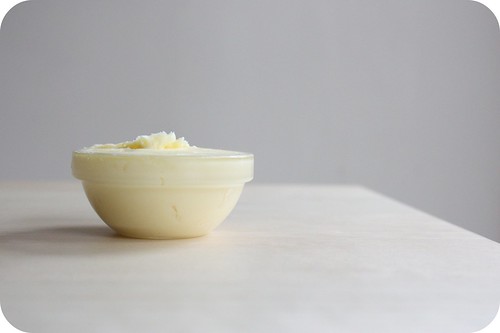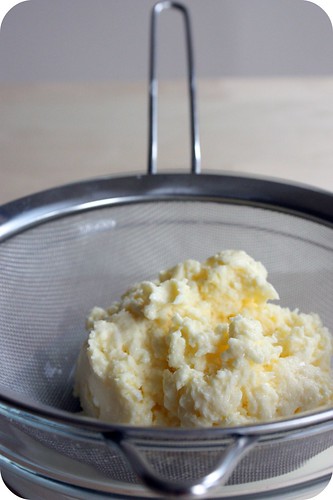
I grew up in a world awash with margarine. I remember dipping my knife into a beige tub of it straight from the refrigerator. With little resistance, I would scoop out a lump and slather it easily onto a whole wheat roll. It melted easily and soaked the bread with its oily yellowness. I didn't think a whole lot about it. It was the nineties, and my parents were into being healthy and exercising. Back then, margarine was part of that.
I can't quite pinpoint the moment my world shifted from margarine as health food to margarine as toxin. It could have been junior year of college when I read Michael Pollan's Omnivore's Dilemma and tried to understand trans fats for the first time. Maybe it really sunk in when New York City's Board of Health became the first in the nation to ban the use of artificial trans fats (the kinds in margarine and other hydrogenated oils) at restaurants. I guess it doesn't really matter when it was, but sometime between Y2K and now, my world changed from one where my friends and family cooked and baked with margarine for "health" to one where they use butter without fail.
Still, the mistaken association between butter and health problems pervades television commercials and women's magazines. Multinational corporations continue to produce butter substitutes made with rancid oils, selling products which are actually far more damaging to our health than the lowest-nutrient butters on the market. Soy, corn and cotton can all be used to make the ingredients that comprise a butter substitute, and food-producing corporations have a glut of all three due to monocropping practices.
The thing is, people will only be swayed by marketing for so long. High quality pastured butters become available at more grocery stores every day, and many boutique food stores now regularly carry cultured butter like that of Vermont Butter and Cheese Company. Once you taste a good cultured butter slathered on fresh bread, you're transported to a world where butter has taste and where it needs some good sea salt, a world where have to ask yourself, "How was I passing this up?".
This post is in the spirit of putting a stop to the passing up of butter. That is my mission, and I hope you'll accept it. I wanted to make butter because I came across this article while internet browsing during lunch at work, and butter making sounded to me both daunting and delicious. Subsequent Googling yielded the unanimous bloggers' consensus that homemade butter is far superior to even that of Vermont Butter and Cheese. I had to know.
And so Mary and I made butter. We bought our cream and yogurt fresh from the farmers' market, we fermented overnight, we cooled the cream in the fridge. We shook a jar for half an hour until the butter separated from the buttermilk, and (Eureka!) we were victorious.
Everyone else on the interweb was right: It's easy to make butter. It tastes good. Oh, does it taste good. And it's good for you. Really, really good. As I understand it, butter made from the milk of cows that have been eating grass (or "pastured") in the fall and spring is high in both Vitamins A and D. It is high in both selenium and cholesterol, protecting against cancer and heart disease. If you have questions about more of the specific health benefits of butter, check out this Weston A. Price Foundation article, "Why Butter Is Better". It will also answer some questions if you scratched your head when I said that cholesterol helps to protect against heart disease. Culturing the butter increases its enzyme content and makes it easier to digest. It also makes it taste even more incredible.

Cultured Butter
Adapted from The Atlantic
1 pint of heavy cream (not ultra-pasteurized; that won't become butter)
3 Tbs. plain yogurt with live cultures
A pinch or two of good sea salt to taste
*Note: Do not make butter on a hot day, as the butter will not separate from the buttermilk properly. I made it on a day that was about 70 degrees, and everything went fine, as I chilled the cream before shaking it.
Pour heavy cream into a mixing bowl and add the yogurt. Stir to mix, cover with a towel, and leave at room temperature for 12 to 24 hours, until the cream has thickened slightly and developed a slightly tangy taste.
Pour cream into a large jar with a lid that closes tightly, and place in the refrigerator for an hour or two. The cream should cool to between 60 and 66 degrees Fahrenheit. Once it has cooled, you can separate the butter from the buttermilk in one of three ways. You can pour it into a food processor and process it for 5 to 6 minutes until the butter separates from the buttermilk. The butter will look clumpy and yellow, and the buttermilk will be a translucent white. You can also mix it with a stand mixer. Just be sure to cover it well so the cream doesn't splash you and your entire kitchen. You can also do it the fun way and work up a sweat like I did. Shake it vigorously in a jar until it separates, about 30 minutes. I recommend finding yourself a shaking buddy and alternating every five minutes.
One the butter has separated from the buttermilk, strain the clump of butter in a colander and reserve the buttermilk for use in another recipe. Place the butter in a large bowl of ice water, and work to buttermilk out of it with your hands. The buttermilk will make the water cloudy. Strain the butter out of that and put it in a new bowl of ice water, repeating this squeezing process until the water stays clear, to to three times. Remove the butter and pat it gently with a towel to remove water droplets on its exterior. Work a couple of pinches of good salt into it with your hands (if you want salted butter). Transfer the butter to a ramekin or small bowl and cover tightly. It will keep for several weeks in the refrigerator, or several months in the freezer.
-Kylie


So true. Real butter may be one of the most delicious things on the planet. I've only tried it once, but now I'm inspired to try making my own!
ReplyDelete-Adriana
This sounds like something that should be experienced on a chiily, wet, Saturday afternoon. But only after we have hit up the "Wise Guys" for our sandwich at the Saturday Redmond Market.
ReplyDelete~Jim
Most definitely! This would be perfect after a Wise Guys sandwich. (But then again, what isn't?)
ReplyDelete-Kylie
hey Adriana, this looks great.
ReplyDeleteYour mom just told me about your adventures in food here.
Do you remember me from the Xmas dinner at your folks house with Rebecca? I run the 300 y/o B&B in Princeton.
Well, keep up the awesome work you two
Bob Riggs
Inn at Glencairn
Princeton
It is always wonderful to see people having success and enjoying what they love! Keep up the good work and I will try some of these delicious recipe's Thanks girls. Julie
ReplyDeleteI'll have the photo thanks
ReplyDeleteBob-Thank you so much for stopping by!
ReplyDeleteJulie-It feels great to be doing the things you love, doesn't it? Thank you, too, for letting us know you're here.
Kitchen Butterfly-Why thank you!